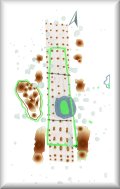







Lech Czerniak
Up until at least the mid third millennium BC, people inhabiting the lowlands of Central Europe lived in small, widely dispersed groups. They subsisted by hunting, fishing and gathering wild plant foods.
However, as early as the second half of the sixth millennium BC, groups of colonists who practised farming, and thus led a sedentary way of life, had already reached some regions within these territories. These colonists arrived from the loess-rich lands around the River Danube (modern-day Hungary, the Czech Republic, Slovakia, Austria and Croatia) in search of new, equally fertile, settlement areas which could sustain a similar form of subsistence economy. Evidence of this first colonization by farming communities can be found in the remains of their buildings and items of material culture (such as pottery vessels, tools made of stone and bone, or ornaments). Burials have also been recorded over a very wide area, from the Paris Basin in the west to the Kuiavia (Kujawy) region in the east, across the Central European belt of lowlands in the north, down to the Danube in the south. The uniformity exhibited among the settlement traces which occur in these areas, in the form of buildings and small finds, is remarkable bearing in mind the vast terrain which they cover, and is accepted as evidence of the colonists' expansion. This cultural phenomenon, the sites and artefact assemblages left behind by the earliest farmers, whose ethnic identity remains unknown, archaeologists refer to as the Linear Band Pottery Culture - a name derived from the most characteristic ornamentation used on pottery of this period (Fig. ) - or the Danubian C Culture, based on the provenance of the earliest vessel types.
The era which saw the emergence of the first Central European farming societies - the Danubian Culture - brought about huge cultural, social and economic changes which were reflected in a rapid rise in population density, increased human exploitation and management of natural resources and, most of all, in the adoption of a new way of life. The meeting of these two culturally very different worlds - those of the hunter-gatherer and the farming societies - must have been particularly dramatic. The native populations inhabiting these territories were highly mobile. Their lives depended on hunting game animals (aurochs, red deer and roe deer), fishing and gathering plant foods, such as hazelnuts, whilst the newly arrived colonists lived in permanent settlements and relied on agriculture and animal husbandry.
These two societies differed from each other in virtually every aspect, from their food procurement strategies to the roles played by men and women and their standing in society, the ways in which they raised their children and their religious beliefs. Increased population among the farming communities, and in consequence, their territorial expansion, finally resulting in the disappearance of hunter-gatherer groups, indicates that the farmers were the historical victors in this cultural clash. Seen from a wider perspective, it appears that the indigenous hunter-gatherers were not actually conquered by the colonists, but merely adopted their agrarian way of life.
For many years, it was believed that this success was based primarily on the fact that farming was a more effective form of subsistence economy than hunting. However, comparative studies into the early agricultural methods have raised doubts as to the validity of this theory. Results from this research indicate that farming settlements must have made a considerable impact on the surrounding environment, destroying the natural resources of the local habitat and thus restricting the scope for continuing a hunter-gatherer way of life. This in turn, left the way open for adopting new cultural traditions and - to a large extent - for hunters to become assimilated into farming communities. One of the features of the pioneer farming societies which was particularly attractive for other groups to adopt were the external trappings of their culture, in the form of material goods (linked to a complex system of religious beliefs and a wealth of rituals derived from the cultural traditions of the Near East) whose main purpose appeared to be to impress.
Of these features, one of the most important were the large houses in which people lived. Let us first imagine the cultural context of the native population, living in small temporary camps consisting of shelters raised in a forest clearing situated near a river bank. Suddenly, what must have seemed gigantic constructions appeared in their local landscape - houses built to a rectangular or trapezoidal ground-plan, measuring over 40 m in length and 7-8 m wide, made of wood covered with clay and painted with colourful spiral and curvilinear motifs. The southern end of these buildings, where the house entrance would have been, was always wider and had an additional upper storey (as evidenced by traces of double posts [Fig. ] in the section marked SE), which further emphasized their monumental appearance. Large swathes of land surrounding these houses were cleared, fenced off and used for crop cultivation. Enclosures for domesticated animals would also have been situated nearby. The species reared included particularly large specimens of aurochs, as well as sheep and goats, which, at the time, were not native to this part of Europe. Farming communities also introduced other novel items, previously unknown among hunter-gatherer societies These included lavishly decorated pottery vessels (Fig. ), some of them of anthropomorphic design (Fig. ), stone axes and adzes (Fig. ), shell ornaments and clothing made of linen and woollen textiles. All were skilfully made and highly valued as exchange goods.
Excavation work carried out along the line of the gas pipeline led to the discovery of over a dozen settlements attesting the presence of the first farming colonists. The finds recorded at these sites serve as a good illustration of the points made above and are presented both in this catalogue and in the exhibition which it accompanies. One of the most striking examples of a settlement dating to the second half of the sixth millennium BC are the traces of a post-built house discovered in the region of Kuiavia, at site 22 near the village of Bożejewice, Strzelno parish. The post-holes recorded here provide evidence of one of the largest buildings known to-date raised by the pioneer farmers. The house measured 43 m in length, its southern end being 7.3 m wide, the northern end - 6.5 m wide. The wooden posts of this construction were dug into clay soil. The building was divided into three rooms, each serving a different purpose. These rooms are marked on the plan as NW (residential - sleeping quarters), M (residential - area for domestic chores) and SE (storage area with upper level serving as a granary). At either end of the house, traces of large pits were found. These had originally been dug in the process of extracting clay for covering the walls of the house. Later (some having had a roof added) they were used as sites for flint-knapping, antler- or stone-working, burning fires (for smoking meat and fish) etc., finally being utilised as rubbish pits. It is largely thanks to their final function that we are now able to recover so many finds which give us an insight into the everyday life and diet of the earliest agriculturalists (Fig. ).
BACK







